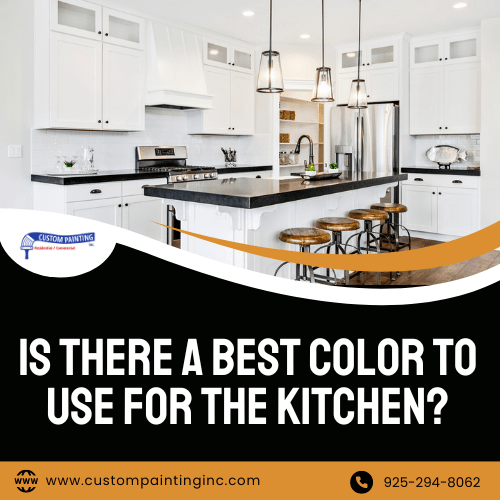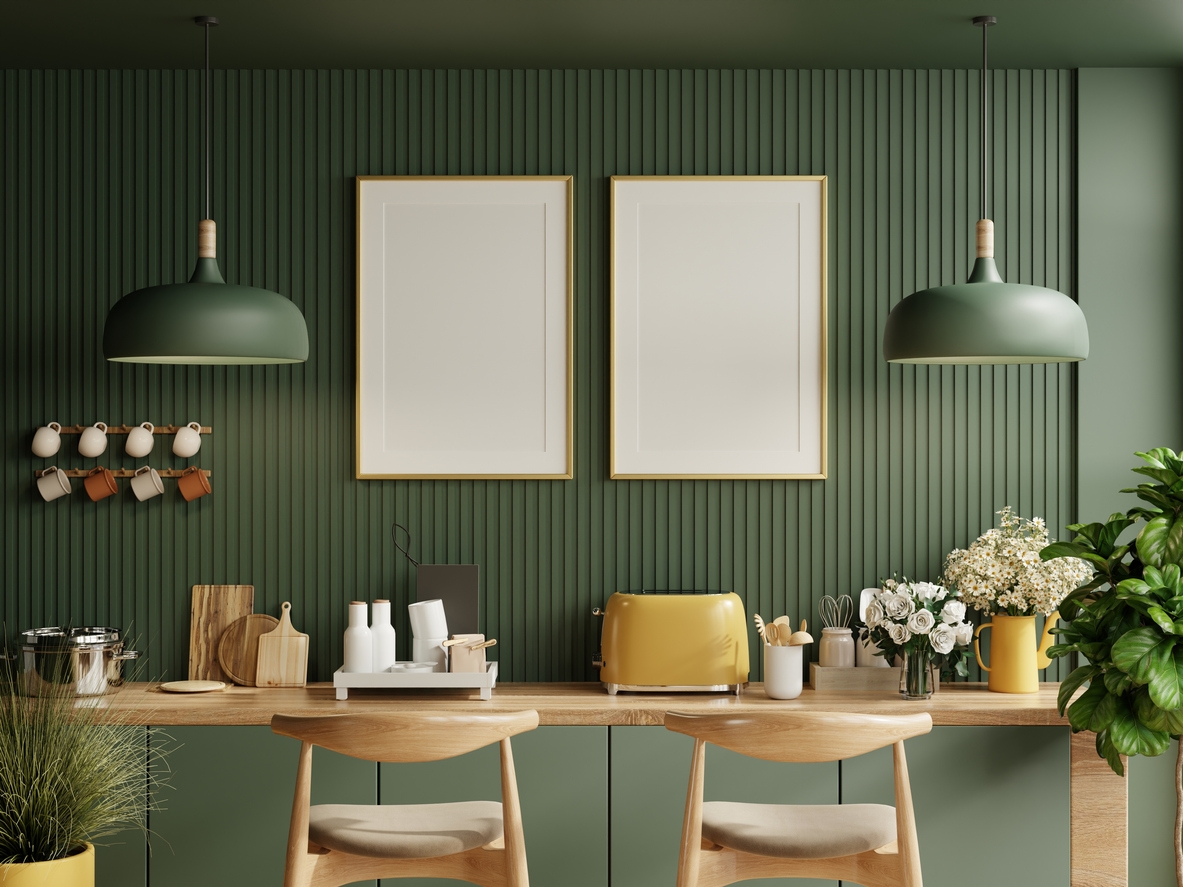While planning a paint project, many homeowners may wonder, “Is there the best color for the kitchen?” Our answer: there’s no such thing as the single “best” color or shade for the kitchen. It depends on many factors, such as the kitchen’s size and layout.
You may have seen a color that you fell in love with and wanted to bring the exact shade to your kitchen walls or cabinets. But without doing research beforehand, that shade may end up looking like a disaster to your kitchen. This article aims to help you prevent that scenario from happening and choose the shade that works most beautifully for your kitchen.
Always Choose Glossy Paints for Kitchens
When shopping for kitchen paints, there’s one thing you should not forget: choose paints with a lustrous finish. A kitchen is one of the high-traffic areas prone to splatters and humidity. It is also subject to frequent cleaning and brushing.
You can choose from several finishes: eggshell, satin, semi-gloss, and glossy. Satin or semi-gloss paints are generally recommended for kitchen walls and cabinets, while glossy paints are better for accents. However, the choice depends on how busy your kitchen is and how willing you are to keep up with the cleaning and maintenance.
Durability and cleaning ease depend on the paint’s gloss level. Generally, the glossier the finish, the more durable and easier to clean the paint is. Semi-gloss and glossy paints are the most durable and convenient to clean, making them perfect for bustling kitchens. However, paints with gloss are not good at hiding imperfections. Plus, applying these paints is tricky. You might need extra time cleaning and preparing the surfaces to ensure they’re smooth and spotless before painting.
Factors in Choosing Colors for Kitchens
Choosing paint colors for kitchens involves several considerations to create a cohesive, functional, and aesthetically pleasing space. Here are key factors to keep in mind:
1. Lighting
- Natural light: Assess the amount of natural light your kitchen receives. Bright, airy spaces can handle darker colors, while dimly lit kitchens benefit from lighter shades to enhance brightness.
- Artificial light: Consider the type of artificial lighting (e.g., warm or cool tones) as it affects how paint colors appear.
2. Kitchen size and layout
- Small kitchens: Light colors can make small kitchens feel more spacious. White, beige, or light pastels work well.
- Large kitchens: Larger kitchens can accommodate bolder, darker colors without feeling cramped.
3. Cabinet and countertop colors
- Ensure the wall color complements the existing colors of your cabinets and countertops. Neutral wall colors often provide a good balance with bold cabinetry.
4. Style and theme
- Modern: Sleek, neutral colors like white, gray, or black.
- Traditional: Warm, inviting colors such as cream, yellow, or soft greens.
- Rustic: Earthy tones like browns, greens, and terracotta.
5. Color psychology
- Warm colors: (reds, oranges, yellows) stimulate appetite and create an inviting atmosphere.
- Cool colors: (blues, greens) provide a calm and relaxing environment.
- Neutrals: Versatile and timeless, neutrals can create a sophisticated backdrop.
6. Personal preference
- Choose colors you love and feel comfortable with, as you’ll spend considerable time in the kitchen.
7. Trends and timelessness
- While it’s tempting to follow trends, consider whether you’ll still like the color in a few years. Timeless colors provide longevity.
8. Functionality and durability
- Use paint with a finish that’s easy to clean and resistant to stains and moisture. Satin or semi-gloss finishes are ideal for kitchens.
9. Adjacent room colors
- Harmonize your kitchen color with the colors of adjoining rooms to ensure a smooth visual transition.
10. Test samples
- Test paint samples on different walls and observe them at various times of the day to see how they look under different lighting conditions.
By considering these factors, you can choose a paint color that enhances the beauty and functionality of your kitchen, creating a space you’ll enjoy for years to come.
The Most Popular Colors and Shades for Kitchens
For kitchen colors and shades, the most recommended options often balance aesthetics, functionality, and personal preference. Here are some popular and well-regarded choices, plus a handful of tips for choosing colors.
1. White and off-white:
- Benefits: Clean, timeless, and makes the space feel larger and brighter.
- Shades: Pure white, ivory, eggshell, and cream.
2. Neutral tones:
- Benefits: Versatile and adaptable to various styles and accessories.
- Shades: Beige, taupe, gray, and greige (a mix of gray and beige).
3. Soft pastels:
- Benefits: Adds a touch of color while maintaining a light and airy feel.
- Shades: Light blue, mint green, blush pink, and soft yellow.
4. Bold colors:
- Benefits: Adds personality and a focal point to the kitchen.
- Shades: Navy blue, forest green, deep red, and charcoal.
5. Earthy tones:
- Benefits: Creates a warm and inviting atmosphere.
- Shades: Terracotta, olive green, mustard yellow, and rust.
6. Two-tone combinations:
- Benefits: Adds depth and interest, breaking the monotony of a single color.
- Combinations: White upper cabinets with dark lower cabinets, gray and blue, or beige and brown.
7. Accent colors:
- Benefits: Accent colors bring a pop of color and can be easily changed with accessories.
- Ideas: Bright red, turquoise, lime green, or orange for small appliances, backsplashes, or bar stools.
Tips for choosing kitchen colors:
- Consider lighting: Natural and artificial lighting can affect how colors appear in your kitchen.
- Match with fixtures: Ensure the colors complement your countertops, cabinets, and flooring.
- Reflect personal style: Choose colors that you enjoy and reflect your taste.
- Test samples: Try paint samples in your kitchen to see how they look at different times of the day.
- Think long-term: Consider how you’ll feel about the colors in the long run, as kitchens are often a long-term investment.
Recommended Colors or Color Schemes for Every Kitchen Style or Theme
If your kitchen has a particular style or theme, check out the recommended color schemes:
1. Modern kitchen:
- Colors: White, black, and gray.
- Accent colors: Stainless steel, bright red, or electric blue.
- Scheme: High-gloss white cabinets with black countertops and stainless-steel appliances. Add a bright color for small accessories or backsplash.
2. Traditional kitchen:
- Colors: Cream, beige, and warm wood tones.
- Accent colors: Soft pastels like sage green or sky blue.
- Scheme: Cream cabinets with wood countertops and a pastel-colored backsplash. Warm wood flooring complements the look.
3. Farmhouse kitchen:
- Colors: Soft white, muted green, and natural wood.
- Accent colors: Navy blue, barn red, or mustard yellow.
- Scheme: White shiplap walls with sage green cabinets and a wooden island. Add navy blue accessories for contrast.
4. Industrial kitchen:
- Colors: Gray, black, and metallics.
- Accent colors: Rust orange, brick red, or mustard.
- Scheme: Exposed brick walls with gray cabinets and black metal accents. Use industrial-style light fixtures and rustic wood elements.
5. Scandinavian kitchen:
- Colors: White, light gray, and natural wood.
- Accent colors: Soft pastel blue, mint green, or blush pink.
- Scheme: White cabinets with light wood countertops and open shelving. Add pastel-colored kitchenware and plants for a touch of color.
6. Mediterranean kitchen:
- Colors: Warm terracotta, olive green, and deep blue.
- Accent colors: Yellow, burnt orange, and turquoise.
- Scheme: Terracotta floor tiles with olive-green cabinets and a deep blue backsplash. Incorporate colorful ceramics and textiles.
7. Coastal kitchen:
- Colors: Light blue, seafoam green, and white.
- Accent colors: Sand beige, coral, and navy.
- Scheme: Light blue cabinets with white countertops and a seafoam green backsplash. Use natural textures like rattan and light wood.
8. Minimalist kitchen:
- Colors: White, soft gray, and black.
- Accent colors: Subtle shades like blush or soft blue.
- Scheme: All-white cabinets and countertops with black hardware. Keep décor minimal and functional with clean lines and uncluttered surfaces.
These color schemes can serve as a starting point to help you achieve the desired style for your kitchen. Adjust the shades and combinations to suit your personal preferences and the specifics of your space.
Final Words
Use our tips and recommendations to guide you through the perfect color scheme for your kitchen. If you need more paint advice or are ready to call a professional, contact Custom Painting, Inc. We’re a locally-owned company specializing in interior and exterior painting for homes and businesses. We have served in cities and communities in the Bay Area, including Danville, Walnut Creek, San Ramon, Pleasanton, and Pleasant Hill, for over 40 years.
Besides painting, we offer light carpentry, repair, custom crown molding installation, and color consultation services. Our licensed and insured crew will make your projects easier and guarantee beautiful results that will last years, providing you peace of mind. Call us at 925-866-9610 or message us via our contact form for a free consultation and estimate.



